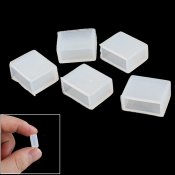Navigation
Install the app
How to install the app on iOS
Follow along with the video below to see how to install our site as a web app on your home screen.
Note: This feature may not be available in some browsers.
More options
You are using an out of date browser. It may not display this or other websites correctly.
You should upgrade or use an alternative browser.
You should upgrade or use an alternative browser.
Last step of waterproofing led strip.
- Thread starter Jon_101
- Start date
- Joined
- Jun 26, 2021
- Messages
- 610
Can you give a bit more in regards to details?
algerdes
Al Gerdes
If you are asking how you can waterproof the end of a strip, and if you are using the sleeved kind - most will put some hot glue in the end, then use shrink tubing as a final barrier.
I have a feeling that they have been clicked "post thread" before attachments have finished uploading.Strip waterproofing
Same case from @Jon_101 a few weeks ago.
HertzSwift
Apprentice elf
i use lots of clear heatshrink and silicon, been repairing my strips for the last 8yrs
if you want pictures i might be able to find some of my process
if you want pictures i might be able to find some of my process
I have a few tips on waterproofing sheathed strip. I have never had moisture in a strip. Firstly, make sure your silicone is good before committing to using it on your strip joins. I had a bad batch of silicone in 2019 which took at least 6 months to set and it was conductive enough to cause flicker during that time. Neutral cure silicone seems to be recommended. I'd advise against choosing really cheap silicone after my experience. Cheap silicone usually works but it is not worth saving $10 when it could potentially put hours of work at risk.
I use the end caps that Brett Douglas posted. Mine came from Ray Wu. When ordering these, ask for wire holes in all of them. Ray assumed that I wanted 50% without holes. I see no need for these. If I don't want to use wires, the silicone glue will close the holes even if they are there. I use silicone glue and don't quite put the cap hard up against the end of the strip's tubing. This creates a buffer so that the solder join is physically protected. I increase this further by pushing the strip into its tubing and using a clothes peg to hold it there whilst the silicone dries. If you want extra physical protection, thick heatshrink can be placed over the end cap but I don't bother.
Avoid heating the strip with the soldering iron for too long. This can cause the copper solder pad to fall off at a later date.
When joining strip end-to-end, I use heatshrik and silicone to seal it. The heatshrink will be invisible as long as it doesn't overlap the LEDs. I have even used black heatshrink to join clear-sheathed strips and it is literally impossible to see the join when the strip is lit up.
When the strip is new, check that the supplier used enough silicone to seal each end.
I use the end caps that Brett Douglas posted. Mine came from Ray Wu. When ordering these, ask for wire holes in all of them. Ray assumed that I wanted 50% without holes. I see no need for these. If I don't want to use wires, the silicone glue will close the holes even if they are there. I use silicone glue and don't quite put the cap hard up against the end of the strip's tubing. This creates a buffer so that the solder join is physically protected. I increase this further by pushing the strip into its tubing and using a clothes peg to hold it there whilst the silicone dries. If you want extra physical protection, thick heatshrink can be placed over the end cap but I don't bother.
Avoid heating the strip with the soldering iron for too long. This can cause the copper solder pad to fall off at a later date.
When joining strip end-to-end, I use heatshrik and silicone to seal it. The heatshrink will be invisible as long as it doesn't overlap the LEDs. I have even used black heatshrink to join clear-sheathed strips and it is literally impossible to see the join when the strip is lit up.
When the strip is new, check that the supplier used enough silicone to seal each end.
Last step of waterproofing LED strip is to store it in the garage in a nice dry place when you replace it with nodes 


